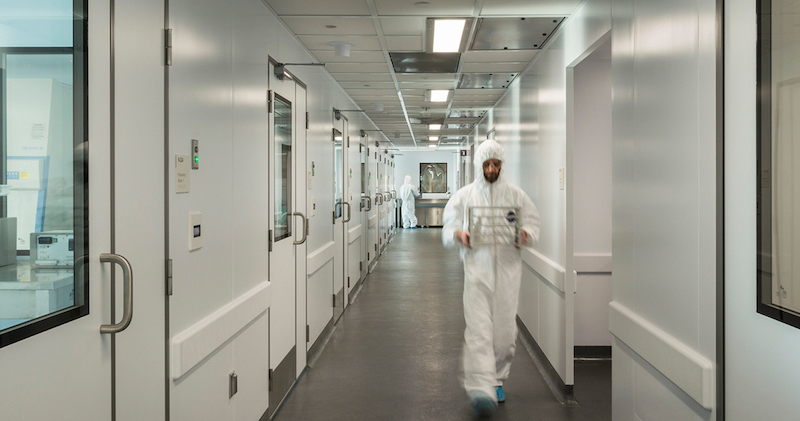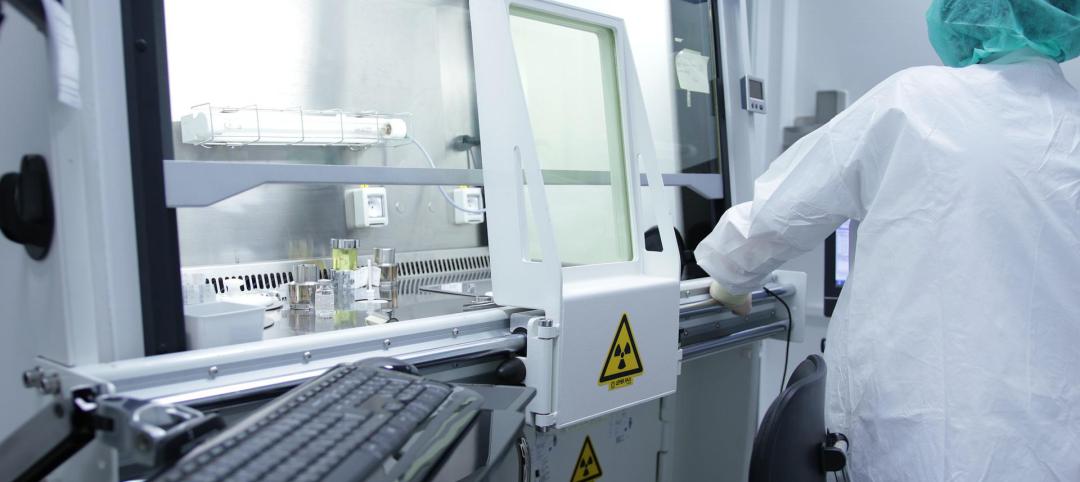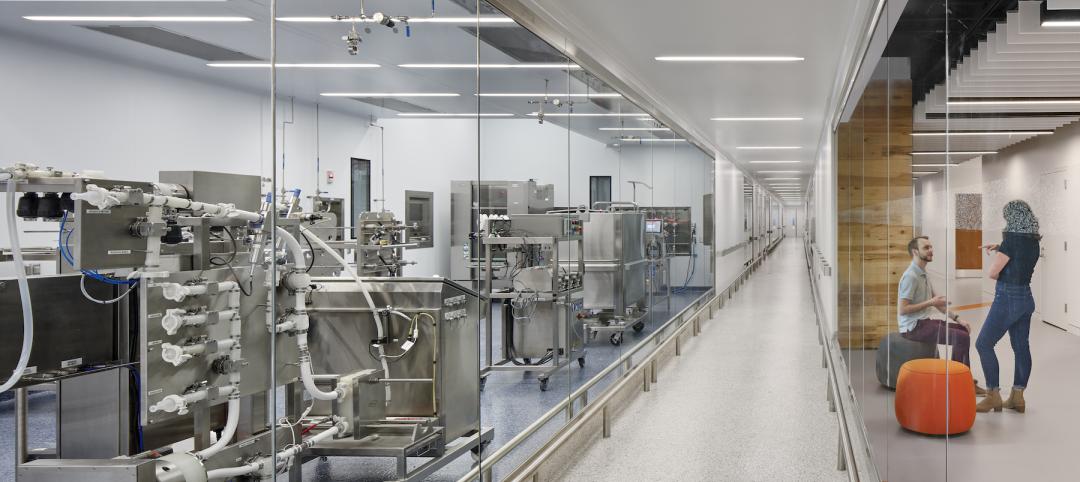Advances in the research and treatment of personalized medicine are making huge waves in the life sciences industry—especially in California. In fact, three of the top 10 ranked life sciences clusters are in California: No. 2, San Francisco; No. 3, San Diego; and No. 9, Los Angeles. Personalized medicine is one of the hottest trends in life science, so there is reason to take note of how the big shift will affect new and existing life science facilities.
Personalized medicine differs significantly from “traditional” research and development processes and is affecting the pharmaceutical manufacturing market in major ways. First, because the therapies produced for personalized medicine are targeted, manufacturing space is shifting from large-scale to small-scale and requires less validated piping and more single-use tubing and products. Second, manufacturing small amounts of these individualized therapies requires technology and equipment that are even more specialized—so having the deep expertise to design optimized, flexible laboratories is crucial.
There are two possible situations that start-ups and developers are encountering at this critical moment: they have existing manufacturing facilities that are not built to address current personalized medicine requirements, or they have available empty shell space for manufacturing that is ready to be designed for small-scale manufacturing. Below are a few major considerations these organizations should consider for small-scale lab manufacturing success.
Be Future-Focused
In this exciting world of personalized medicine, the spaces we design must be able to respond on a dime to evolving innovations and changing technologies. A laboratory designer who specializes in small-scale lab manufacturing should work with your team to anticipate space needs far into the future. We are seeing industry advancements such as Green Chemistry and 3D “bioprinting” technology that are completely changing current Good Manufacturing Processes (cGMP) and decreasing some typical standard process needs. The increased use of AI to complete redundant tasks is also affecting the way we design QA/QC laboratories and other support spaces. Having a broad understanding of how future innovations and technology can influence design saves time and money when planning a manufacturing space.
Understand Your End-User
Personalized medicine research and development requires the highest-quality individualized environments. Understanding the end-users who will ultimately occupy your space is critical. To design a truly innovative facility that will stand out to potential tenants or internal teams, consider both current design factors and possible building solutions that can be incorporated into the design now to adapt to future technology and manufacturing processes.
Also, consider what your end-users will manufacture within the facility. What public spaces will facilitate each user’s mission and culture? Often, the design focus is only on spaces that the FDA will visit and audit, but what about spaces intended to wow potential investors, patients and press? Support spaces often become important at this stage—not only for the scientists and researchers who occupy the space, but also for external audiences whom they need to impress.
Ensure Your Site is Large Enough
Even with this smaller-scale manufacturing, careful consideration and allocation of site space are essential to ensure necessary utilities perform optimally. Make sure there are adequate pads for outdoor generators. There are also many other utilities to consider, including cooling towers, transformers, gas, and delivery of materials. We recommend including a multi-story warehouse space with a full-height mechanical mezzanine. Additionally, loading requirements and truck turnarounds will ensure that your site is flexible enough for different forms of manufacturing.
Consider Your Contamination Strategy
Often, there are too few streams dedicated to materials handling in and out of facilities. Contamination is a major risk for pharmaceutical manufacturing, and small-scale manufacturing only magnifies this risk. Ensure that the building has enough dock doors and that dedicated paths exist for moving new materials into, and waste out of, the facility. We know that waste streams must be separated with both dedicated doors and physical barriers. Establishing non-crossing waste, finished product and raw materials streams are essential to FDA validation.
Make Security a Top Priority
With personalized medicine comes cutting-edge innovations, technologies, and even processes that are proprietary; these systems and spaces require space design that ensures confidentiality. Manufacturing spaces must have a high level of security in place that strategically considers design elements, such as where natural daylight and views into the facility are appropriate. This level of security not only needs to be integrated internally, but also should be a part of the overall design of the facility. The facility should look exciting, open, and welcoming while also maintaining security levels to safeguard proprietary processes.
Realize the True Ratios for Support Space
It may be surprising how much support space is recommended for small-scale lab manufacturing. For a 5,000-sf ISO-8 and tighter classified space, the recommended support space size should be at least three times the ISO space. These support spaces are critical to the facility’s success. Be sure to consider airlocks, storage and direct support spaces as these areas are often overlooked in a facility plan. Additionally, mechanical and other building support spaces dedicated to clean rooms and clean room support require adequate space—whether on a full-height mezzanine or outside the building. These clean manufacturing support areas can occupy large amounts of space, so understanding the need for such space is essential to the facility’s overall design.
Related Stories
Data Centers | Nov 28, 2022
Data centers are a hot market—don't waste the heat!
SmithGroup's Brian Rener shares a few ways to integrate data centers in mixed-use sites, utilizing waste heat to optimize the energy demands of the buildings.
School Construction | Oct 31, 2022
Claremont McKenna College science center will foster integrated disciplinary research
The design of the Robert Day Sciences Center at Claremont McKenna College will support “a powerful, multi-disciplinary, computational approach to the grand socio-scientific challenges and opportunities of our time—gene, brain, and climate,” says Hiram E. Chodosh, college president.
Higher Education | Oct 24, 2022
Wellesley College science complex modernizes facility while preserving architectural heritage
A recently completed expansion and renovation of Wellesley College’s science complex yielded a modernized structure for 21st century STEM education while preserving important historical features.
Laboratories | Oct 5, 2022
Bigger is better for a maturing life sciences sector
CRB's latest report predicts more diversification and vertical integration in research and production.
Laboratories | Sep 12, 2022
Lab space scarcity propels construction demand in life sciences sector
In its 2021 Life Sciences Real Estate Outlook, JLL predicted that access to talent would be a primary concern for an industry sector that had been growing by leaps and bounds. A year later, talent still guides real estate decisions. But market conditions of a different sort were cooling the biotech field: namely, investors that have soured on startups which underperformed after going public. What this means for new construction and renovation going forward is unpredictable, as the drivers behind life sciences’ surge are still palpable.
| Sep 2, 2022
New UMass Medical School building enables expanded medical class sizes, research labs
A new nine-story, 350,000 sf biomedical research and education facility under construction at the University of Massachusetts Chan Medical School in Worcester, Mass., will accommodate larger class sizes and extensive lab space.
Giants 400 | Aug 22, 2022
Top 70 Science + Technology Facility Contractors + CM Firms 2022
Whiting-Turner, Hensel Phelps, DPR Construction, and Skanska USA top the rankings of the nation's largest science and technology (S+T) facility contractors and construction management (CM) firms, as reported in Building Design+Construction's 2022 Giants 400 Report.
Giants 400 | Aug 22, 2022
Top 70 Science + Technology Facility Engineering + EA Firms 2022
Jacobs, CRB, Fluor, and Affiliated Engineers Inc. head the rankings of the nation's largest science and technology (S+T) facility engineering and engineering/architecture (EA) firms, as reported in Building Design+Construction's 2022 Giants 400 Report.
Giants 400 | Aug 22, 2022
Top 100 Science + Technology Facility Architecture + AE Firms 2022
HDR, Flad Architects, Gensler, and DGA top the rankings of the nation's largest science and technology (S+T) facility architecture and architecture/engineering (AE) firms, as reported in Building Design+Construction's 2022 Giants 400 Report.
Giants 400 | Aug 22, 2022
Top 45 Laboratory Facility Contractors and Construction Management Firms for 2022
Whiting-Turner, Hensel Phelps, McCarthy, and STO Building Group top the ranking of the nation's largest science and technology (S+T) laboratory facility contractors and construction management (CM) firms, as reported in Building Design+Construction's 2022 Giants 400 Report.

















